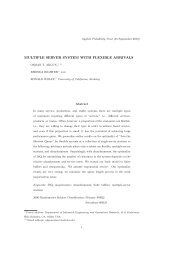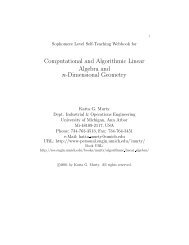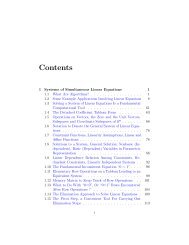Chapter 1 LINEAR COMPLEMENTARITY PROBLEM, ITS ...
Chapter 1 LINEAR COMPLEMENTARITY PROBLEM, ITS ...
Chapter 1 LINEAR COMPLEMENTARITY PROBLEM, ITS ...
You also want an ePaper? Increase the reach of your titles
YUMPU automatically turns print PDFs into web optimized ePapers that Google loves.
4 <strong>Chapter</strong> 1. Linear Complementarity Problem, Its Geometry, and Applications<br />
same direction, it is the set of points f y : > = 0g. Given x 2 R n , by moving from<br />
x in the direction y we get points of the form x + y where > = 0, and the set of all<br />
such points fx + y : > = 0g is the hal ine or ray through x in the direction y. The<br />
point x + y for >0issaidtohave been obtained by moving from x in the direction<br />
y a step length of . As an example, if y =(1 1) T 2 R n , the ray of y is the set of all<br />
points of the form f( ) T : > = 0g. In addition, if, x =(1 ;1) T , the hal ine through<br />
x in the direction y is the set of all points of the form f(1 + ;1+ ) T : > = 0g. See<br />
Figure 1.2. In this half-line, letting =9,we get the point (10 8) T , and this point is<br />
obtained by taking a step of length 9 from x =(1 ;1) T in the direction y =(1 1) T .<br />
1.1.2 Complementary Cones<br />
y<br />
x<br />
y<br />
Ray of<br />
x<br />
Half-line or ray through<br />
in the direction of y<br />
Figure 1.2 Rays and Half-Lines<br />
In the LCP (q M), the complementary cones are de ned by the matrix M. The point<br />
q does not play any role in the de nition of complementary cones.<br />
Let M be a given square matrix of order n. For obtaining C(M), the class of<br />
complementary cones corresponding to M, the pair of column vectors (I.j ;M.j) is










